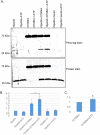Identification of an Important Orphan Histidine Kinase for the Initiation of Sporulation and Enterotoxin Production by Clostridium perfringens Type F Strain SM101
- PMID: 30670619
- PMCID: PMC6343041
- DOI: 10.1128/mBio.02674-18
Identification of an Important Orphan Histidine Kinase for the Initiation of Sporulation and Enterotoxin Production by Clostridium perfringens Type F Strain SM101
Abstract
Clostridium perfringens type F strains cause a common human foodborne illness and many cases of nonfoodborne human gastrointestinal diseases. Sporulation plays two critical roles during type F enteric disease. First, it produces broadly resistant spores that facilitate type F strain survival in the food and nosocomial environments. Second, production of C. perfringens enterotoxin (CPE), the toxin responsible for causing the enteric symptoms of type F diseases, is restricted to cells in the process of sporulation. While later steps in the regulation of C. perfringens sporulation have been discerned, the process leading to phosphorylation of Spo0A, the master early regulator of sporulation and consequent CPE production, has remained unknown. Using an insertional mutagenesis approach, the current study identified the orphan histidine kinase CPR0195 as an important factor regulating C. perfringens sporulation and CPE production. Specifically, a CPR0195 null mutant of type F strain SM101 made 103-fold fewer spores than its wild-type parent and produced no detectable CPE. In contrast, a null mutant of another putative C. perfringens orphan histidine kinase (CPR1055) did not significantly affect sporulation or CPE production. Studies using a spoIIA operon promoter-driven reporter plasmid indicated that CPR0195 functions early during sporulation, i.e., prior to production of sporulation-associated sigma factors. Furthermore, in vitro studies showed that the CPR0195 kinase domain can autophosphorylate and phosphorylate Spo0A. These results support the idea of CPR0195 as an important kinase that initiates C. perfringens sporulation by directly phosphorylating Spo0A. This kinase could represent a novel therapeutic target to block C. perfringens sporulation and CPE production during type F disease.IMPORTANCEClostridium perfringens type F enteric diseases, which include a very common form of food poisoning and many cases of antibiotic-associated diarrhea, develop when type F strains sporulate and produce C. perfringens enterotoxin (CPE) in the intestines. Spores are also important for transmission of type F disease. Despite the importance of sporulation for type F disease and the evidence that C. perfringens sporulation begins with phosphorylation of the Spo0A transcriptional regulator, the kinase phosphorylating Spo0A to initiate sporulation and CPE production had not been ascertained. In response, the current report now provides identification of an orphan histidine kinase named CPR0195 that can directly phosphorylate Spo0A. Results using a CPR0195 null mutant indicate that this kinase is very important for initiating C. perfringens sporulation and CPE production. Therefore, the CPR0195 kinase represents a potential target to block type F disease by interfering with intestinal C. perfringens sporulation and CPE production.
Keywords: Clostridium perfringens; enterotoxin; histidine kinase; sporulation.
Copyright © 2019 Freedman et al.
Figures







Similar articles
-
Identification of orphan histidine kinases that impact sporulation and enterotoxin production by Clostridium perfringens type F strain SM101 in a pathophysiologically-relevant ex vivo mouse intestinal contents model.PLoS Pathog. 2023 Jun 1;19(6):e1011429. doi: 10.1371/journal.ppat.1011429. eCollection 2023 Jun. PLoS Pathog. 2023. PMID: 37262083 Free PMC article.
-
The biology and pathogenicity of Clostridium perfringens type F: a common human enteropathogen with a new(ish) name.Microbiol Mol Biol Rev. 2024 Sep 26;88(3):e0014023. doi: 10.1128/mmbr.00140-23. Epub 2024 Jun 12. Microbiol Mol Biol Rev. 2024. PMID: 38864615 Free PMC article. Review.
-
Overexpressing the cpr1953 Orphan Histidine Kinase Gene in the Absence of cpr1954 Orphan Histidine Kinase Gene Expression, or Vice Versa, Is Sufficient to Obtain Significant Sporulation and Strong Production of Clostridium perfringens Enterotoxin or Spo0A by Clostridium perfringens Type F Strain SM101.Toxins (Basel). 2024 Apr 18;16(4):195. doi: 10.3390/toxins16040195. Toxins (Basel). 2024. PMID: 38668620 Free PMC article.
-
NanH Is Produced by Sporulating Cultures of Clostridium perfringens Type F Food Poisoning Strains and Enhances the Cytotoxicity of C. perfringens Enterotoxin.mSphere. 2021 Apr 28;6(2):e00176-21. doi: 10.1128/mSphere.00176-21. mSphere. 2021. PMID: 33910991 Free PMC article.
-
Clostridium perfringens Sporulation and Sporulation-Associated Toxin Production.Microbiol Spectr. 2016 Jun;4(3):10.1128/microbiolspec.TBS-0022-2015. doi: 10.1128/microbiolspec.TBS-0022-2015. Microbiol Spectr. 2016. PMID: 27337447 Free PMC article. Review.
Cited by
-
Genetic mechanisms governing sporulation initiation in Clostridioides difficile.Curr Opin Microbiol. 2022 Apr;66:32-38. doi: 10.1016/j.mib.2021.12.001. Epub 2021 Dec 18. Curr Opin Microbiol. 2022. PMID: 34933206 Free PMC article. Review.
-
Identification of Functional Spo0A Residues Critical for Sporulation in Clostridioides difficile.J Mol Biol. 2022 Jul 15;434(13):167641. doi: 10.1016/j.jmb.2022.167641. Epub 2022 May 18. J Mol Biol. 2022. PMID: 35597553 Free PMC article.
-
Identification of orphan histidine kinases that impact sporulation and enterotoxin production by Clostridium perfringens type F strain SM101 in a pathophysiologically-relevant ex vivo mouse intestinal contents model.PLoS Pathog. 2023 Jun 1;19(6):e1011429. doi: 10.1371/journal.ppat.1011429. eCollection 2023 Jun. PLoS Pathog. 2023. PMID: 37262083 Free PMC article.
-
The impact of orphan histidine kinases and phosphotransfer proteins on the regulation of clostridial sporulation initiation.mBio. 2024 Apr 10;15(4):e0224823. doi: 10.1128/mbio.02248-23. Epub 2024 Mar 13. mBio. 2024. PMID: 38477571 Free PMC article. Review.
-
The biology and pathogenicity of Clostridium perfringens type F: a common human enteropathogen with a new(ish) name.Microbiol Mol Biol Rev. 2024 Sep 26;88(3):e0014023. doi: 10.1128/mmbr.00140-23. Epub 2024 Jun 12. Microbiol Mol Biol Rev. 2024. PMID: 38864615 Free PMC article. Review.
References
-
- McClane BA, Robertson SL, Li J. 2013. Clostridium perfringens, p 465–489. In Doyle MP, Buchanan RL (ed), Food microbiology: fundamentals and frontiers (4th ed). ASM Press, Washington, DC.
-
- Sarker MR, Shivers RP, Sparks SG, Juneja VK, McClane BA. 2000. Comparative experiments to examine the effects of heating on vegetative cells and spores of Clostridium perfringens isolates carrying plasmid genes versus chromosomal enterotoxin genes. Appl Environ Microbiol 66:3234–3240. doi:10.1128/AEM.66.8.3234-3240.2000. - DOI - PMC - PubMed
Publication types
MeSH terms
Substances
Grants and funding
LinkOut - more resources
Full Text Sources
Molecular Biology Databases
Research Materials
Miscellaneous

